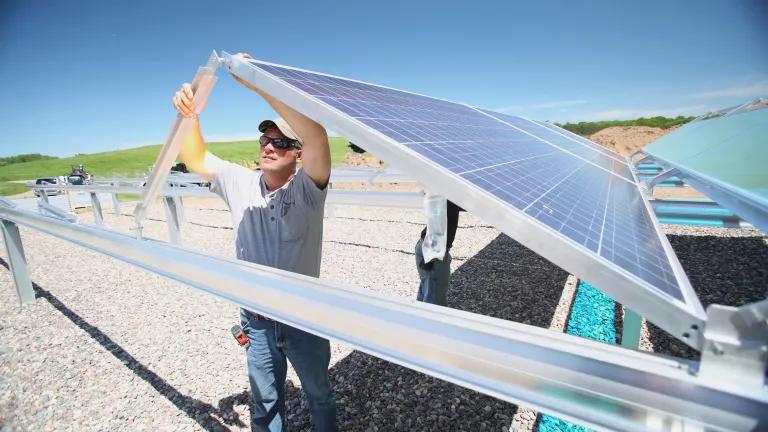Battery Storage Can Maintain Reliability, Even After Fossils Retire
New analysis shows that Illinois can maintain reliability even after retiring fossil resources by deploying 3 GW of 4-hour battery storage.

In 2021, Illinois passed the landmark Climate and Equitable Jobs Act (CEJA), charting a path toward 100% clean energy by 2045. CEJA mandates the staggered retirement of Illinois’ fleet of fossil fuel plants, prioritizing the dirtiest plants and those located near environmental justice communities.
In the years following CEJA’s enactment, grid planners have begun to grapple with the law’s ramifications. Can the electricity system operate reliably without much gas and coal, resources long seen as the bedrock of the power system of the Midwest?
New analysis from NRDC and Astrapé Consulting shows that Illinois can maintain a reliable system even after retiring over 11.5 gigawatts (GW) of fossil resources by deploying 3 GW of 4-hour battery storage and ensuring that sufficient resources in the interconnection queue come online in the Illinois zone by 2030.
To answer the grid planner’s question: yes, the region can remain reliable while complying with CEJA, and it can do so without delaying fossil fuel retirements.
As our colleague wrote in a previous blog, batteries can be a game changer for the power grid. Battery storage can deliver huge benefits at a time when extreme weather, policy-driven resource retirements and load growth are testing the limits of the power system. This study further demonstrates that battery storage is more than just an auxiliary resource. It can contribute to baseline reliability and resilience.
What our study showed
NRDC and Astrapé’s new analysis extends previous analysis conducted by PJM, which aimed to evaluate the system-wide impact of CEJA-related retirements. PJM’s analysis had a frightening conclusion: that CEJA carried a $700 million price tag to be borne by the entire region by 2030. These astounding costs were driven by the projected need to upgrade the transmission system to import remote power into Illinois. But PJM missed a crucial component in their methodology: the addition of sufficient replacement resources and new energy storage within the Illinois region.
From a resource adequacy perspective, our new analysis demonstrates that adding around 3 GW of storage capacity in the Illinois zone by 2030—along with weighted generator additions from both MISO and PJM’s interconnection queues—can resolve the reliability challenges associated with retiring generation under CEJA. Even better, the same amount of storage is also enough to reduce Illinois’s projected reliance on imports from other regions, providing a new way to solve the problem that PJM’s transmission grid upgrades were originally designed to fix.
What does this mean for Illinois?
Implementing policies like CEJA will require hard work on behalf of the state, including strong, supportive energy storage policy and effective collaboration between the state and its RTOs (MISO and PJM).
Statewide financial incentives and strong storage-specific targets can help ensure that storage resources are built at the rate we need them, especially with resource retirements on the horizon. States like California have proven this by setting favorable storage policies that have catalyzed a boom in storage development. Following suit, Illinois must take an active role in assessing the system-wide need for storage resources and commit to a strong and consumer-friendly storage policy.
This analysis shows the minimum amount of storage needed to maintain reliability – but Illinois should think of this as a floor, not a ceiling. Storage provides a host of benefits to the power grid and is crucial to help Illinois meet its clean energy targets. To make this a reality, Illinois must undertake comprehensive state energy modeling, commit to informed storage targets, and ensure adequate replacement clean energy is built in-state.
States must also do their part to coordinate with RTOs. Illinois must be proactive to ensure that retiring resources communicate with their respective RTOs, so that clean replacement resources can overcome permitting hurdles and interconnect as soon as possible. The Illinois Commerce Commission, through the Renewable Energy Access Plan (REAP), has already committed to better coordination with its RTOs to improve both interconnection and transmission planning processes. As we detailed in a previous blog, it’s now time for ICC to get to work.
What does this mean for PJM?
Energy storage needs to be considered when planning for system-wide capacity losses and fully valued for its contribution to reliability. It’s not just about keeping the lights on–PJM can save consumers money by preventing costly, unnecessary upgrades by analyzing the entire available solution-set.
Retiring resources are a growing concern for PJM. The grid operator fears that retiring resources will result in electricity shortfalls which can cause blackouts, or the need to build expensive transmission upgrades to maintain a reliable system. This concern is real–it’s PJM’s duty to keep the lights on at the lowest possible cost, and the region is facing load growth from data centers and electrification policies.
But PJM has a more sophisticated set of options available rather than just reverting to a fossil fuel status quo. We have technical solutions available, so long as PJM’s bureaucracy can adapt. Solutions are within PJM’s control.
The first thing PJM can do is simple: comply with FERC’s landmark transmission planning rule, Order 1920. Our colleague Tom Rutigliano details how PJM can act swiftly to kick off good transmission planning before the leaves turn.
The second thing PJM can do is plan for resource retirements and new entries together, as NRDC and partner organizations explained to the PJM board. This common-sense planning is not happening in PJM, where the planning for resource retirements and replacements happens in different stakeholder groups with different timelines. The good news is that stakeholders voted by a landslide to break down these silos and get to work. Now we finally have an opportunity to plan for retirements and replacements, and we hope that PJM will realistically approach the potential for batteries to reduce costs and provide reliability.
The third thing, more broadly, is ensuring that storage resources are adequately valued. PJM must not exclude storage resources from interconnection processes or write them off as a solution to retiring fossil plants.
Doing these three things means we can avoid another Brandon Shores, where PJM forced an expensive, uncompetitive, and highly polluting retiring coal plant into a “reliability must-run” agreement, keeping the plant online until 2028. Instead of taking advantage of years of warning and proactively looking for low-cost alternatives to Brandon Shores, PJM’s inaction left Maryland ratepayers with a $1 billion bill, plus $780 million in transmission upgrades once Brandon Shores eventually retires.
Looking ahead
We can’t have a repeat of Brandon Shores in Illinois (or anywhere). To comply with CEJA, PJM must allow resources in Illinois to retire on time. To maintain reliability, PJM must facilitate the efficient exit and entry of new resources.
Illinois has an important role to play too. A reliable system is within reach for the state, if it commits to doing the work necessary to secure it.
And while this analysis is specific to Illinois, its findings ring wider and echo what we saw in California this summer: storage is ready for the spotlight. Now it’s up to states and grid operators to commit and scale it up.



